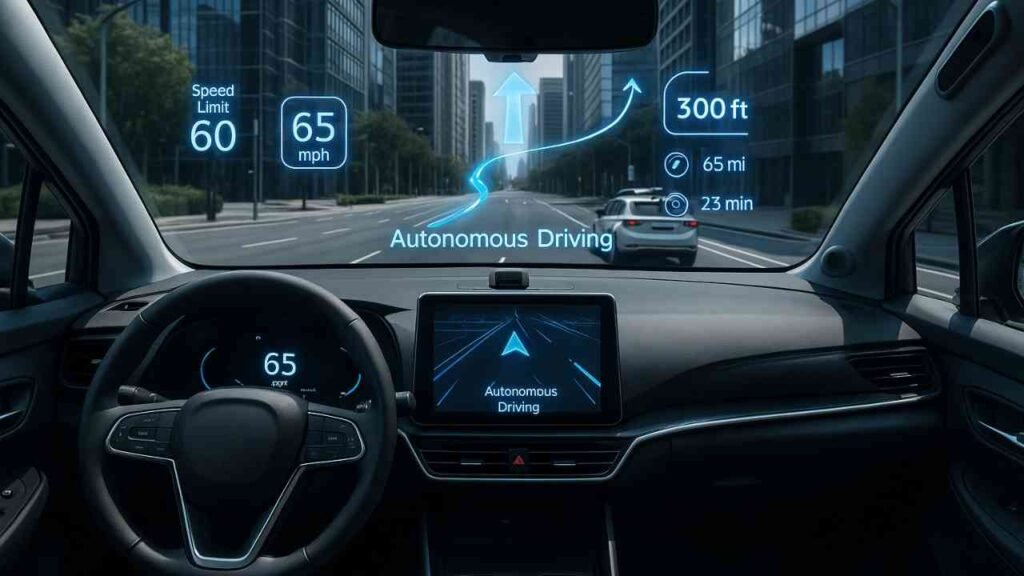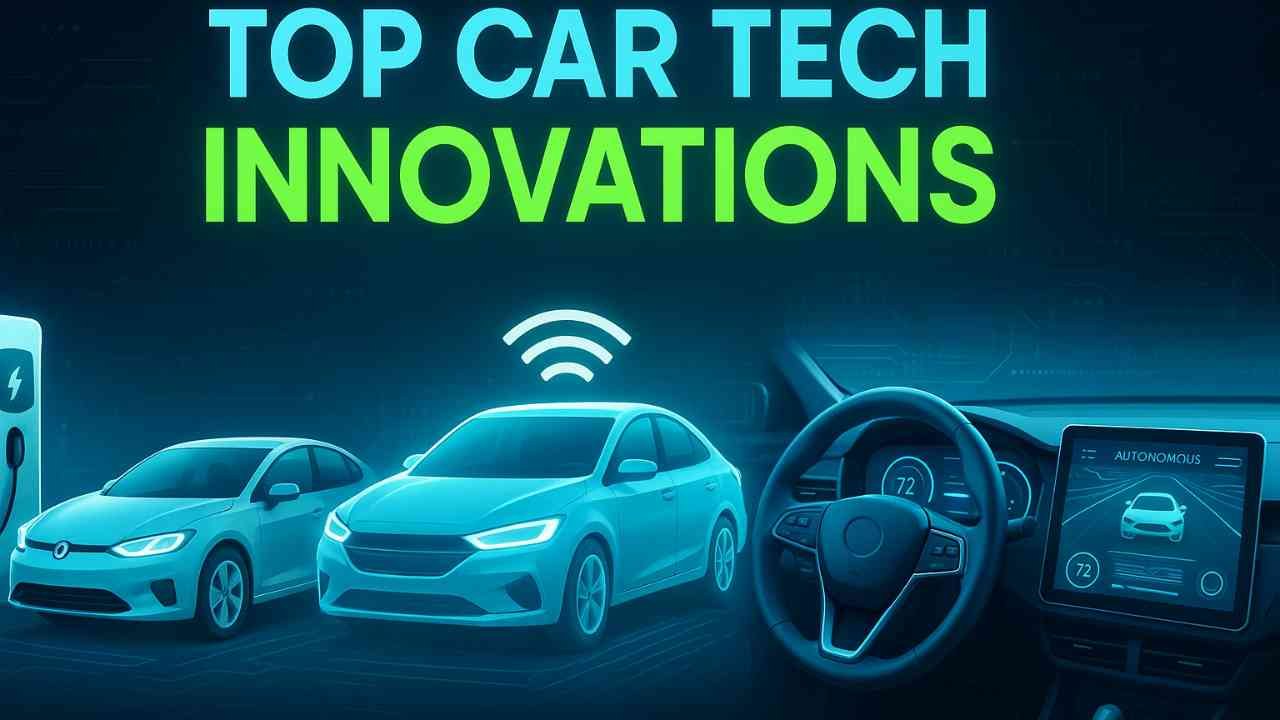Introduction
The automotive industry is continuously evolving with groundbreaking technological innovations that enhance driving experiences, safety, and convenience. From autonomous driving systems to electric powertrains, the future of cars is being shaped by these technologies. In this article, we’ll explore some of the top car tech innovations that are set to redefine how we drive in the coming years.
Autonomous Driving Technology

Why It’s Important:
Self-driving cars are no longer a thing of the future; they are quickly becoming a reality. Autonomous driving technology uses a combination of sensors, cameras, radar, and artificial intelligence to enable vehicles to drive themselves without human intervention.
- Key Features:
- Level 3 Autonomy: Cars with Level 3 autonomy can drive themselves in most conditions, with limited human intervention required.
- Safety Benefits: Autonomous cars aim to reduce accidents caused by human error, improving road safety.
- Self-Parking Systems: Many modern cars come equipped with self-parking technology, which allows them to park themselves in tight spots.
Electric Powertrains
Why It’s Important:
Electric powertrains are rapidly replacing traditional gasoline engines in vehicles. With zero emissions and lower operating costs, electric cars are becoming increasingly popular. The innovation in battery technology is allowing electric vehicles (EVs) to have longer ranges, faster charging times, and lower costs.
- Key Features:
- Battery Innovations: New solid-state and lithium-ion batteries offer higher energy densities, longer lifespans, and faster charging.
- Charging Infrastructure: Public charging stations are expanding globally, making it easier than ever to charge electric vehicles.
- Range Improvements: EVs are now offering ranges that can compete with traditional gasoline-powered cars, with some models offering over 400 miles per charge.
Vehicle-to-Everything (V2X) Communication
Why It’s Important:
Vehicle-to-Everything (V2X) communication allows vehicles to communicate with each other and with infrastructure like traffic lights, road signs, and pedestrian systems. This innovation is helping make roads safer and more efficient by improving traffic management and reducing accidents.
- Key Features:
- V2V (Vehicle-to-Vehicle): Vehicles can exchange information about their speed, position, and road conditions, helping prevent collisions.
- V2I (Vehicle-to-Infrastructure): Cars can communicate with traffic lights and road signs to optimize traffic flow and reduce congestion.
- V2P (Vehicle-to-Pedestrian): The technology helps detect pedestrians, cyclists, and other road users, improving safety for everyone.
Augmented Reality Dashboards
Why It’s Important:
Augmented Reality (AR) dashboards are revolutionizing the way drivers interact with their cars. By projecting navigation directions, speed, and other vital information onto the windshield, AR dashboards allow drivers to keep their eyes on the road while still receiving critical information.
- Key Features:
- Navigation Directions on Windshield: AR systems project turn-by-turn directions directly onto the windshield, helping drivers stay focused and avoid distractions.
- Real-Time Data: Important data such as vehicle speed, fuel efficiency, and safety alerts are displayed clearly on the windshield.
- Enhanced Safety: By providing a clearer view of the road and relevant data, AR dashboards help reduce driver distraction and increase safety.
Advanced Driver Assistance Systems (ADAS)
Why It’s Important:
ADAS are technologies that assist drivers in making safe decisions, minimizing the risk of accidents, and improving the overall driving experience. These systems are increasingly common in modern vehicles and are laying the groundwork for full autonomy.
- Key Features:
- Lane-Departure Warning: Alerts drivers when they unintentionally drift out of their lane, reducing the risk of accidents.
- Adaptive Cruise Control: Automatically adjusts the car’s speed to maintain a safe distance from the vehicle ahead.
- Blind Spot Detection: Helps drivers see vehicles in their blind spots, enhancing safety when changing lanes.
Smart Keyless Entry and Start Systems
Why It’s Important:
Keyless entry and start systems are becoming standard in many vehicles, offering a convenient and secure way to access and start your car. These systems use a smart key fob or a mobile phone app to allow you to unlock your car, start the engine, and even drive away without taking the key out of your pocket or bag.
- Key Features:
- Keyless Entry: Unlock your car automatically as you approach, with no need to take out a key.
- Push-Button Start: Start the engine with the push of a button, making it easier and faster to get going.
- Smartphone Integration: Some vehicles now allow you to use your smartphone as a key, enabling even greater convenience and control.
Advanced Lighting Systems
Why It’s Important:
Advancements in lighting technology are making driving safer and more efficient. Modern lighting systems, including adaptive headlights and LED lights, improve visibility and reduce the risk of accidents at night or in low-visibility conditions.
- Key Features:
- Adaptive Headlights: These headlights adjust to the car’s speed and steering angle, providing better illumination on curves and bends in the road.
- LED and Laser Lights: LED and laser headlights offer brighter, more energy-efficient lighting that enhances visibility without blinding other drivers.
- Smart Taillights: Advanced taillight systems can communicate with other vehicles, improving overall road safety.
In-Car Connectivity and Infotainment Systems
Why It’s Important:
As cars become smarter, in-car connectivity and infotainment systems are becoming increasingly advanced. These systems allow drivers and passengers to connect their smartphones, stream music, access navigation, and even control the car’s functions through voice commands or touchscreens.
- Key Features:
- Apple CarPlay and Android Auto: These systems allow seamless integration between your car and smartphone, giving you access to apps, messages, and calls while driving.
- Voice Control: Use voice commands to control navigation, music, and other functions without taking your hands off the wheel.
- Wireless Charging: Some cars now feature wireless charging pads, so you can charge your devices while on the go.
Conclusion
The future of automotive technology is exciting and full of possibilities. From autonomous driving and electric powertrains to smart connectivity and advanced safety features, these innovations are shaping the cars of tomorrow. As we move into 2025 and beyond, expect even more breakthroughs that will make driving safer, more efficient, and more enjoyable.
